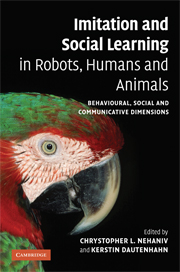 Imitation and Social Learning in Robots, Humans and Animals
Imitation and Social Learning in Robots, Humans and Animals Published online by Cambridge University Press: 10 December 2009
The problem for one individual of producing behaviour that matches, in some aspect, with behaviour it observes in another comprises an instance of the correspondence problem (compare Part IV, Development and embodiment, this volume; Nehaniv and Dautenhahn, 2002). The particular nature of the kind of similarity that is matched determines different classes of correspondence problems. The bodies and affordances available to the two individuals are in general not the same, so the problem is non-trivial – even ignoring the complexities of perception in registering the observed behaviour. Mechanisms for solving these correspondence problems are numerous, and, while generally occurring in a social context, they may or may not involve learning. On the other hand, every social learning mechanism solves a particular class of correspondence problems.
Geoffrey Bird and Cecilia Heyes discuss several alternative mechanisms for solving correspondence problems in which the observer must generate motor commands to match visual input. Of particular interest due to the complexity of mechanism they appear to require for their solution are cases in which the perceptual discrepancies cannot be used as simple feedback to guide mismatch reduction and achieve matching behaviour. Various levels of such perceptual opacity occur when the visual experience in observing another individual and the experience which occurs when carrying out the ‘same’ actions are dissimilar, as in a curtsy bow or in playing tennis.
To save this book to your Kindle, first ensure [email protected] is added to your Approved Personal Document E-mail List under your Personal Document Settings on the Manage Your Content and Devices page of your Amazon account. Then enter the ‘name’ part of your Kindle email address below. Find out more about saving to your Kindle.
Note you can select to save to either the @free.kindle.com or @kindle.com variations. ‘@free.kindle.com’ emails are free but can only be saved to your device when it is connected to wi-fi. ‘@kindle.com’ emails can be delivered even when you are not connected to wi-fi, but note that service fees apply.
Find out more about the Kindle Personal Document Service.
To save content items to your account, please confirm that you agree to abide by our usage policies. If this is the first time you use this feature, you will be asked to authorise Cambridge Core to connect with your account. Find out more about saving content to Dropbox.
To save content items to your account, please confirm that you agree to abide by our usage policies. If this is the first time you use this feature, you will be asked to authorise Cambridge Core to connect with your account. Find out more about saving content to Google Drive.